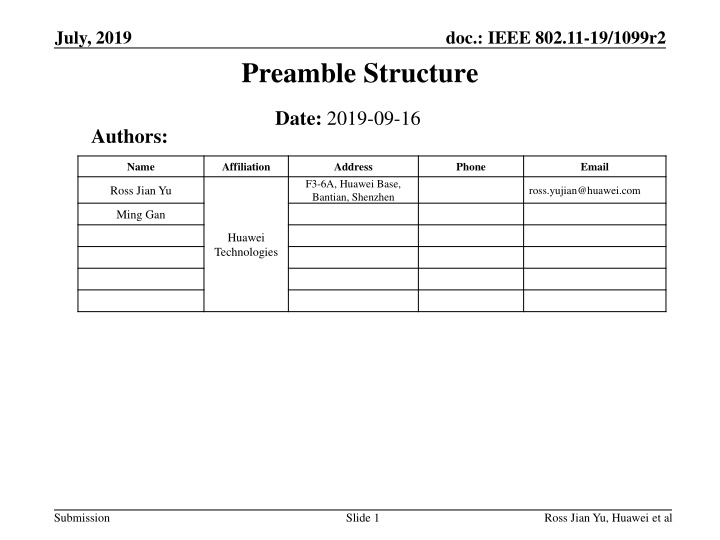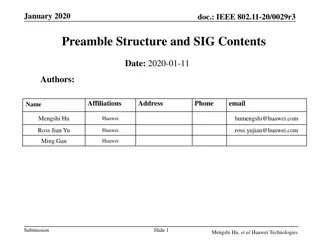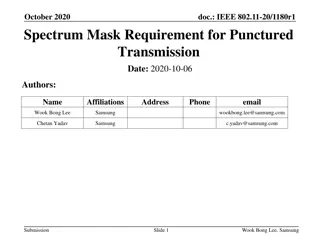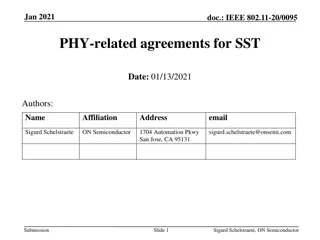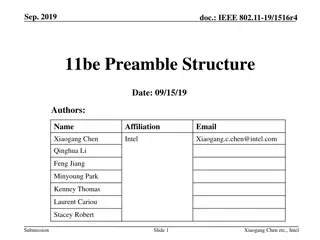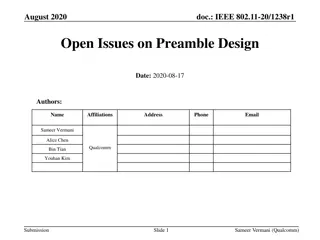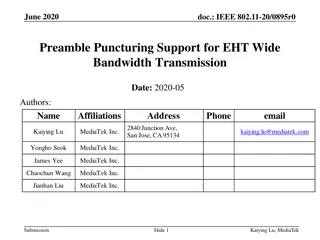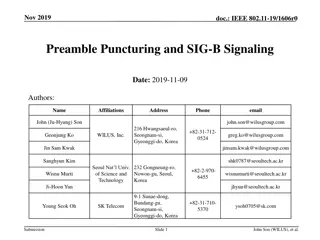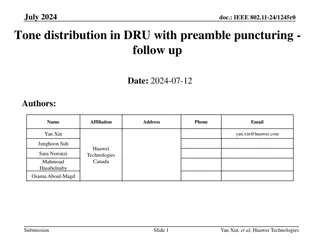IEEE 802.11-19/1099r2 Preamble Structure Overview
The document discusses the specific preamble structures of IEEE standards such as 802.11n, 802.11ac, and the newer 802.11ax (11ax). It explores the functionalities provided by these preambles including synchronization, auto-detection, channel estimation, and more. The focus is on how different standards use phase rotation and symbol repetition for auto-detection, with a particular emphasis on the 11ax preamble structure. The need for L-preamble in EHT/11be modes for backward compatibility with legacy devices is also highlighted.
Download Presentation

Please find below an Image/Link to download the presentation.
The content on the website is provided AS IS for your information and personal use only. It may not be sold, licensed, or shared on other websites without obtaining consent from the author.If you encounter any issues during the download, it is possible that the publisher has removed the file from their server.
You are allowed to download the files provided on this website for personal or commercial use, subject to the condition that they are used lawfully. All files are the property of their respective owners.
The content on the website is provided AS IS for your information and personal use only. It may not be sold, licensed, or shared on other websites without obtaining consent from the author.
E N D
Presentation Transcript
July, 2019 doc.: IEEE 802.11-19/1099r2 Preamble Structure Date: 2019-09-16 Authors: Name Affiliation Address Phone Email F3-6A, Huawei Base, Bantian, Shenzhen Ross Jian Yu ross.yujian@huawei.com Ming Gan Huawei Technologies Submission Slide 1 Ross Jian Yu, Huawei et al
July, 2019 doc.: IEEE 802.11-19/1099r2 Background Each standard has its specific preamble, which provides functions including synchronization, AGC, time/frequency correction, channel estimation, auto-detection and signaling etc. Regarding auto-detection, 11n and 11ac PPDU rely on the phase rotation to do auto-detection: QBPSK QBPSK BPSK 11n MF HT-SIG- 1 HT-SIG -2 L-STF L-LTF L-SIG HT-STF HT-LTF Data BPSK BPSK QBPSK 11ac VHT- SIG-A1 VHT-SIG- A2 VHT- STF VHT- LTF VHT- SIG-B L-STF L-LTF L-SIG Data BPSK/QPSK/ 16QAM/64QAM BPSK 11a/g Data Symbol1 Data Symbol2 L-STF L-LTF L-SIG ... Submission Slide 2 Ross Jian Yu, Huawei et al
July, 2019 doc.: IEEE 802.11-19/1099r2 Background 11ax relies on L-SIG length and RL-SIG (symbol repetition) to first identify 11ax PPDU, and further relies on format subfield in HE-SIG- A, and the phase rotation of HE-SIG-A2 to identify four different HE formats: BPSK BPSK BPSK BPSK Data (STA1) 11ax SU HE-SIG- A1 HE-SIG- A2 HE-STF HE-LTF PE L-STF L-LTF L-SIG RL-SIG BPSK/QPSK/ 16QAM/64QAM BPSK BPSK BPSK BPSK Data (STA1) HE-STF HE-LTF PE 11ax MU HE-SIG- A1 HE-SIG- A2 L-STF L-LTF L-SIG RL-SIG HE-SIG-B HE-STF HE-LTF Data (STA2) PE HE-STF HE-LTF Data (STA3) PE BPSK BPSK BPSK BPSK Data (STA1) HE-STF HE-LTF PE 11ax TB HE-SIG- A1 HE-SIG- A2 L-STF L-LTF L-SIG RL-SIG HE-STF HE-LTF Data (STA2) PE HE-STF HE-LTF Data (STA3) PE BPSK BPSK BPSK QBPSK Data (STA1) 11ax ER SU HE-SIG- A1 HE-SIG- A2 HE-SIG- A3 HE-SIG- A4 HE-STF HE-LTF PE L-STF L-LTF L-SIG RL-SIG Submission Slide 3 Ross Jian Yu, Huawei et al
July, 2019 doc.: IEEE 802.11-19/1099r2 Preamble structure in 11be Several aspects are discussed in this presentation: L-preamble Auto-detection: potential methods to identify EHT PPDU How many EHT modes EHT-SIG-A/SIG-B Submission Slide 4 Ross Jian Yu, Huawei et al
July, 2019 doc.: IEEE 802.11-19/1099r2 L-preamble According to the PAR [1], EHT/11be should ensure backward compatibility and coexistence with legacy IEEE Std. 802.11 compliant devices operating in the 2.4 GHz, 5 GHz, and 6 GHz bands. Hence L-preamble is still needed in at least one mode of EHT PPDU. L-STF L-LTF L-SIG ... L-preamble is duplicated when BW > 20MHz. For EHT PPDU that is <=160Mhz, can reuse the existing tone rotation _(k,BW). For PPDU that is >160Mhz, new _(k,BW) is needed. Submission Slide 5 Ross Jian Yu, Huawei et al
July, 2019 doc.: IEEE 802.11-19/1099r2 EHT Auto-detection Several aspects need to be considered regarding auto-detection: It was discussed in 11ax [2] and 11ba[3] that the first symbol after L-SIG should be BPSK modulated to spoof HT devices so that HT devices will respect the length in L-SIG. Hence BPSK modulated symbol after L-SIG shall also be used in 11be. RL-SIG: outdoor operation is still within the focus of the 11be PAR [1]. RL-SIG may still be needed. Whilst in order to differentiate from 11ax, a different version of RL-SIG may be needed, e.g., negative L-SIG or other sequence masked L-SIG. Other features like phase rotation can further help 11be PPDU to differentiate from 11ax. A signature/mark symbol with fixed bits [3,4] can also be considered as a way to do EHT auto-detection. BPSK modulated SYM L-STF L-LTF L-SIG ... Submission Slide 6 Ross Jian Yu, Huawei et al
July, 2019 doc.: IEEE 802.11-19/1099r2 EHT PPDU formats Non-HT has one format; HT has one MF format and one GF format; VHT has one single format which supports both SU and MU MIMO; whilst HE has four formats: SU, MU, TB and ER SU. For EHT, DL/UL OFDMA and MU-MIMO features should be still considered. Hence EHT MU and EHT TB PPDU formats should be still considered. As outdoor operation is still needed, EHT ER SU PPDU formats should also be considered, together with EHT SU PPDU format. For AP coordination, if a new PPDU format or preamble structure is needed can be further discussed: Can reuse the above mentioned format and be transparent to STAs. Can design a new preamble which contains signaling information from multiple APs. Submission Slide 7 Ross Jian Yu, Huawei et al
July, 2019 doc.: IEEE 802.11-19/1099r2 EHT-SIG-A/SIG-B More bits are likely needed for 11be to support features like: 320Mhz (larger BW bitwidth, more OFDMA users) 16SS (larger Nsts/spatial configuration bitwidth) HARQ (RV, HARQ process ID ) AP coordination (TBD) Hence, a way of transmitting signaling field more efficiently is needed, e.g.,: Previously, SIG-A and SIG-B are encoded based on a 20MHz unit. For EHT, part of EHT-SIG-A/SIG-B can be encoded based on 40MHz or larger unit. Larger number of content channels for EHT-SIG-B Also, because different features need very different number of signaling bits, a EHT-SIG-A field with variable number of OFDM symbols may also be needed. Submission Slide 8 Ross Jian Yu, Huawei et al
July, 2019 doc.: IEEE 802.11-19/1099r2 Wrap up Several aspects regarding preamble structure are discussed in presentation. More work regarding solution details and simulations need to be done later. Submission Slide 9 Ross Jian Yu, Huawei et al
July, 2019 doc.: IEEE 802.11-19/1099r2 SP1 Do you agree that for EHT PPDU, L-STF, L-LTF and L-SIG shall be transmitted at the beginning of the EHT PPDU? Submission Slide 10 Ross Jian Yu, Huawei et al
July, 2019 doc.: IEEE 802.11-19/1099r2 SP2 Do you agree that for EHT PPDU, the first symbol after L-SIG shall be BPSK modulated? Submission Slide 11 Ross Jian Yu, Huawei et al
July, 2019 doc.: IEEE 802.11-19/1099r2 Motion Move to add the followings to the 11be SFD: For EHT PPDU, L-STF, L-LTF and L-SIG shall be transmitted at the beginning of the EHT PPDU. For EHT PPDU, the first symbol after L-SIG shall be BPSK modulated. Submission Slide 12 Ross Jian Yu, Huawei et al
July, 2019 doc.: IEEE 802.11-19/1099r2 Reference 1. 2. 802.11 EHT Proposed PAR, 18/1231-r6, Laurent Cariou (Intel) Preamble design and auto-detection, 15/579r4, Hongyuan Zhang (Marvel) A comparison of BPSK-Mark Options, 18/1156r1, Alphan Sahin (InterDigital) Autodetection with signature symbol, 15/0643r0, Sriram Venkateswaran (Broadcom) 3. 4. Submission Slide 13 Ross Jian Yu, Huawei et al
